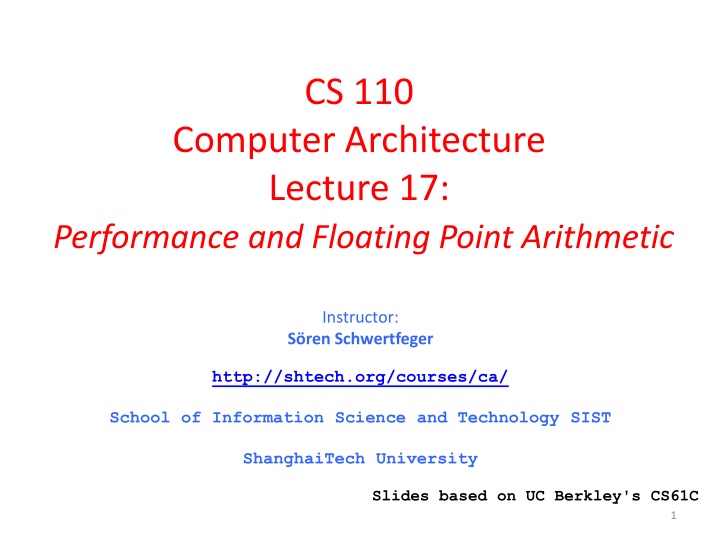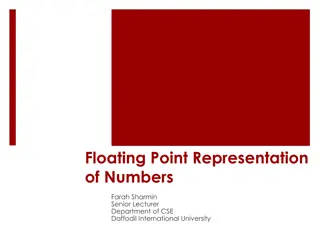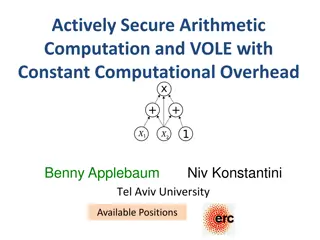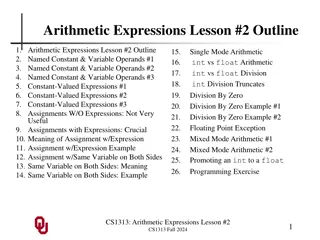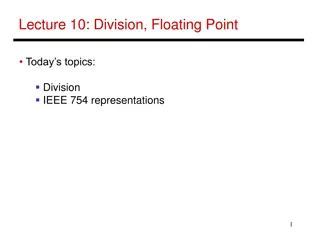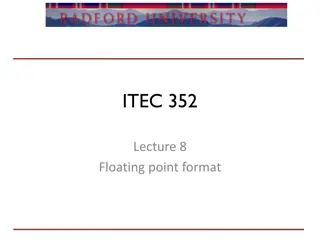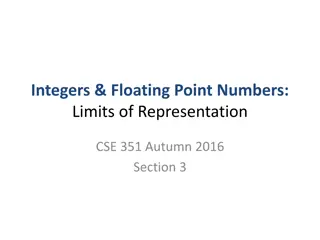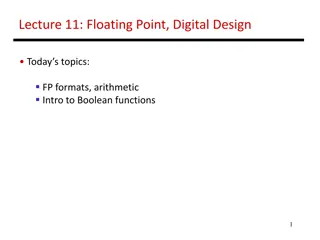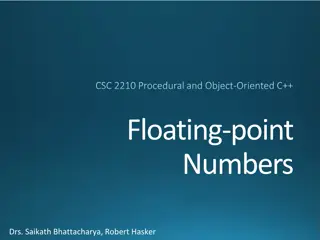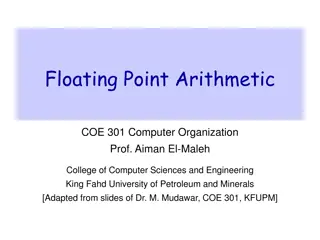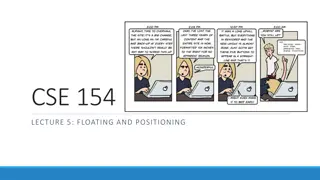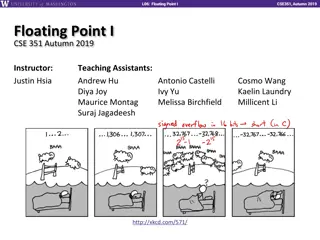Performance and Floating Point Arithmetic in Computer Architecture
This lecture covers the importance of performance and floating-point arithmetic in computer architecture. Topics include parallel computing, CPU performance, application latency, defining relative performance, and measuring CPU performance using clock cycles. Understand the key metrics such as latency, throughput, and response time, and their impact on overall system efficiency and user experience.
Download Presentation

Please find below an Image/Link to download the presentation.
The content on the website is provided AS IS for your information and personal use only. It may not be sold, licensed, or shared on other websites without obtaining consent from the author.If you encounter any issues during the download, it is possible that the publisher has removed the file from their server.
You are allowed to download the files provided on this website for personal or commercial use, subject to the condition that they are used lawfully. All files are the property of their respective owners.
The content on the website is provided AS IS for your information and personal use only. It may not be sold, licensed, or shared on other websites without obtaining consent from the author.
E N D
Presentation Transcript
CS 110 Computer Architecture Lecture 17: Performance and Floating Point Arithmetic Instructor: S ren Schwertfeger http://shtech.org/courses/ca/ School of Information Science and Technology SIST ShanghaiTech University Slides based on UC Berkley's CS61C 1
New-School Machine Structures (It s a bit more complicated!) Software Hardware Parallel Requests Assigned to computer e.g., Search Katz Parallel Threads Assigned to core e.g., Lookup, Ads Parallel Instructions >1 instruction @ one time e.g., 5 pipelined instructions Parallel Data >1 data item @ one time e.g., Add of 4 pairs of words Hardware descriptions All gates @ one time Programming Languages Smart Phone Warehouse Scale Computer Harness Parallelism & Achieve High Performance How do we know? Computer Core Core Memory (Cache) Input/Output Core Functional Unit(s) Instruction Unit(s) A3+B3 A2+B2 A1+B1 A0+B0 Cache Memory Logic Gates 2
What is Performance? Latency (or response time or execution time) Time to complete one task Bandwidth (or throughput) Tasks completed per unit time 3
Cloud Performance: Why Application Latency Matters Key figure of merit: application responsiveness Longer the delay, the fewer the user clicks, the less the user happiness, and the lower the revenue per user 4
Defining CPU Performance What does it mean to say X is faster than Y? Ferrari vs. School Bus? 2013 Ferrari 599 GTB 2 passengers, quarter mile in 10 secs 2013 Type D school bus 50 passengers, quarter mile in 20 secs Response Time (Latency): e.g., time to travel mile Throughput (Bandwidth): e.g., passenger-mi in 1 hour 5
Defining Relative CPU Performance PerformanceX = 1/Program Execution TimeX PerformanceX > PerformanceY => 1/Execution TimeX > 1/Execution Timey => Execution TimeY > Execution TimeX Computer X is N times faster than Computer Y PerformanceX / PerformanceY = N or Execution TimeY / Execution TimeX = N Bus to Ferrari performance: Program: Transfer 1000 passengers for 1 mile Bus: 3,200 sec, Ferrari: 40,000 sec 6
Measuring CPU Performance Computers use a clock to determine when events takes place within hardware Clock cycles: discrete time intervals aka clocks, cycles, clock periods, clock ticks Clock rate or clock frequency: clock cycles per second (inverse of clock cycle time) 3 GigaHertz clock rate => clock cycle time = 1/(3x109) seconds clock cycle time = 333 picoseconds (ps) 7
CPU Performance Factors To distinguish between processor time and I/O, CPU time is time spent in processor CPU Time/Program = Clock Cycles/Program x Clock Cycle Time Or CPU Time/Program = Clock Cycles/Program Clock Rate 8
Iron Law of Performance A program executes instructions CPU Time/Program = Clock Cycles/Program x Clock Cycle Time = Instructions/Program x Average Clock Cycles/Instruction x Clock Cycle Time 1st term called Instruction Count 2nd term abbreviated CPI for average Clock Cycles Per Instruction 3rd term is 1 / Clock rate 9
Restating Performance Equation Time = Seconds Program Instructions Clock cycles Seconds Program Instruction Clock Cycle = 10
What Affects Each Component? A)Instruction Count, B)CPI, C)Clock Rate Affects What? Algorithm Programming Language Compiler Instruction Set Architecture 11
What Affects Each Component? Instruction Count, CPI, Clock Rate Affects What? Instruction Count, CPI Instruction Count, CPI Instruction Count, CPI Instruction Count, Clock Rate, CPI Algorithm Programming Language Compiler Instruction Set Architecture 12
Clickers Computer Clock Clock cycles per instruction #instructions per program frequency A 1GHz 2 1000 B 2GHz 5 800 C 500MHz 1.25 400 D 5GHz 10 2000 Which computer has the highest performance for a given program? 13
Clickers Computer Clock Clock cycles per instruction #instructions per program Calculation frequency A 1GHz 2 1000 1ns * 2 * 1000 = 2 s B 2GHz 5 800 0.5ns 5 *800 = 2 s C 500MHz 1.25 400 2ns 1.25 * 400 = 1 s D 5GHz 10 2000 0.2ns * 10 * 2000 = 4 s Which computer has the highest performance for a given program? 14
Workload and Benchmark Workload: Set of programs run on a computer Actual collection of applications run or made from real programs to approximate such a mix Specifies programs, inputs, and relative frequencies Benchmark: Program selected for use in comparing computer performance Benchmarks form a workload Usually standardized so that many use them 15
SPEC (System Performance Evaluation Cooperative) Computer Vendor cooperative for benchmarks, started in 1989 SPECCPU2006 12 Integer Programs 17 Floating-Point Programs Often turn into number where bigger is faster SPECratio: reference execution time on old reference computer divide by execution time on new computer to get an effective speed-up 16
SPECINT2006 on AMD Barcelona Instruc- tion Count (B) time (ps) Interpreted string processing 2,118 0.75 2,389 0.85 1,050 1.72 Combinatorial optimization 336 10.0 1,658 1.09 2,783 0.80 2,176 0.96 Quantum computer simulation 1,623 1.61 3,102 0.80 Discrete event simulation library 587 2.94 1,082 1.79 1,058 2.70 Clock cycle Execu- tion Time (s) Refer- ence Time (s) SPEC- ratio Description CPI 400 400 400 637 817 724 9,770 9,650 8,050 15.3 11.8 11.1 Block-sorting compression GNU C compiler 400 400 400 400 1,345 721 890 837 9,120 10,490 9,330 12,100 6.8 14.6 10.5 14.5 Go game Search gene sequence Chess game 400 400 1,047 993 20,720 22,130 19.8 22.3 Video compression 400 400 400 690 773 6,250 7,020 6,900 9.1 9.1 6.0 Games/path finding 1,143 17 XML parsing
Summarizing Performance System Rate (Task 1) Rate (Task 2) A 10 20 B 20 10 Clickers: Which system is faster? A: System A B: System B C: Same performance D: Unanswerable question! 18
Depends Whos Selling Average System Rate (Task 1) Rate (Task 2) 15 A 10 20 15 B 20 10 Average throughput Average System Rate (Task 1) Rate (Task 2) 1.25 A 0.50 2.00 1.00 B 1.00 1.00 Throughput relative to B Average System Rate (Task 1) Rate (Task 2) 1.00 A 1.00 1.00 1.25 B 2.00 0.50 Throughput relative to A 19
Summarizing SPEC Performance Varies from 6x to 22x faster than reference computer Geometric mean of ratios: N-th root of product of N ratios Geometric Mean gives same relative answer no matter what computer is used as reference Geometric Mean for Barcelona is 11.7 20
Administrivia Proj 2.1 will be posted tomorrow Next weeks lab: Lab 8 will be posted tomorrow In parallel: Project checkup! HW 6 will come soon, too 21
Review of Numbers Computers are made to deal with numbers What can we represent in N bits? 2N things, and no more! They could be Unsigned integers: 0 to 2N - 1 (for N=32, 2N 1= 4,294,967,295) Signed Integers (Two s Complement) -2(N-1) to 2(N-1) - 1 (for N=32, 2(N-1) = 2,147,483,648)
What about other numbers? 1. Very large numbers? (seconds/millennium) = 31,556,926,00010 (3.155692610 x 1010) Very small numbers? (Bohr radius) = 0.000000000052917710m (5.2917710 x 10-11) Numbers with both integer & fractional parts? = 1.5 First consider #3. our solution will also help with #1 and #2. 2. 3.
Representation of Fractions Binary Point like decimal point signifies boundary between integer and fractional parts: xx.yyyy Example 6-bit representation: 21 2-22-3 2-4 20 2-1 10.1010two = 1x21 + 1x2-1 + 1x2-3 = 2.625ten If we assume fixed binary point , range of 6-bit representations with this format: 0 to 3.9375 (almost 4)
Fractional Powers of 2 i 2-i 0 1.0 1 0.5 2 0.25 3 0.125 4 0.0625 5 0.03125 1/32 6 0.015625 7 0.0078125 8 0.00390625 9 0.001953125 10 0.0009765625 11 0.00048828125 12 0.000244140625 13 0.0001220703125 14 0.00006103515625 15 0.000030517578125 1 1/4 1/8 1/16 1/2
Representation of Fractions with Fixed Pt. What about addition and multiplication? 01.100 1.5ten + 00.100 0.5ten 10.000 2.0ten Addition is straightforward: 01.100 1.5ten 00.100 0.5ten 00 000 000 00 0110 0 00000 00000 0000110000 Multiplication a bit more complex: Where s the answer, 0.11? (need to remember where point is)
Representation of Fractions So far, in our examples we used a fixed binary point. What we really want is to float the binary point. Why? Floating binary point most effective use of our limited bits (and thus more accuracy in our number representation): example: put 0.1640625ten into binary. Represent with 5-bits choosing where to put the binary point. 000000.001010100000 Store these bits and keep track of the binary point 2 places to the left of the MSB Any other solution would lose accuracy! With floating-point rep., each numeral carries an exponent field recording the whereabouts of its binary point. The binary point can be outside the stored bits, so very large and small numbers can be represented.
Scientific Notation (in Decimal) mantissa exponent 6.02ten x 1023 radix (base) decimal point Normalized form: no leadings 0s (exactly one digit to left of decimal point) Alternatives to representing 1/1,000,000,000 Normalized: 1.0 x 10-9 Not normalized: 0.1 x 10-8,10.0 x 10-10
Scientific Notation (in Binary) mantissa exponent 1.01two x 2-1 radix (base) binary point Computer arithmetic that supports it called floating point, because it represents numbers where the binary point is not fixed, as it is for integers Declare such variable in C as float double for double precision.
Floating-Point Representation (1/2) Normal format: +1.xxx xtwo*2yyy ytwo Multiple of Word Size (32 bits) 31 S Exponent 1 bit 8 bits S represents Sign Exponent represents y s Significand represents x s Represent numbers as small as 2.0ten x 10-38 to as large as 2.0ten x 1038 30 2322 0 Significand 23 bits
Floating-Point Representation (2/2) What if result too large? (> 2.0x1038 , < -2.0x1038 ) Overflow! = Exponent larger than represented in 8-bit Exponent field What if result too small? (>0 & < 2.0x10-38 , <0 & > -2.0x10-38 ) Underflow! = Negative exponent larger than represented in 8-bit Exponent field underflow overflow overflow 2x1038 -2x1038 -1 -2x10-38 02x10-38 1 What would help reduce chances of overflow and/or underflow?
IEEE 754 Floating-Point Standard (1/3) Single Precision (Double Precision similar): 31 S Exponent 1 bit 8 bits 0 30 2322 Significand 23 bits Sign bit: 1 means negative 0 means positive Significand in sign-magnitude format (not 2 s complement) To pack more bits, leading 1 implicit for normalized numbers 1 + 23 bits single, 1 + 52 bits double always true: 0 < Significand < 1 (for normalized numbers) Note: 0 has no leading 1, so reserve exponent value 0 just for number 0
IEEE 754 Floating Point Standard (2/3) IEEE 754 uses biased exponent representation Designers wanted FP numbers to be used even if no FP hardware; e.g., sort records with FP numbers using integer compares Wanted bigger (integer) exponent field to represent bigger numbers 2 s complement poses a problem (because negative numbers look bigger) Use just magnitude and offset by half the range
IEEE 754 Floating Point Standard (3/3) Called Biased Notation, where bias is number subtracted to get final number IEEE 754 uses bias of 127 for single prec. Subtract 127 from Exponent field to get actual value for exponent Summary (single precision): 31 S Exponent 1 bit 8 bits (-1)S x (1 + Significand) x 2(Exponent-127) Double precision identical, except with exponent bias of 1023 (half, quad similar) 30 2322 0 Significand 23 bits
Question Guess this Floating Point number: 1 1000 0000 1000 0000 0000 0000 0000 000 A: -1x 2128 B: +1x 2-128 C: -1x 21 D: +1.5x 2-1 E: -1.5x 21 35
Representation for In FP, divide by 0 should produce , not overflow. Why? OK to do further computations with E.g., X/0 > Y may be a valid comparison IEEE 754 represents Most positive exponent reserved for Significands all zeroes
Representation for 0 Represent 0? exponent all zeroes significand all zeroes What about sign? Both cases valid +0: 0 00000000 00000000000000000000000 -0: 1 00000000 00000000000000000000000
Special Numbers What have we defined so far? (Single Precision) Exponent Significand 0 0 0 nonzero 1-254 anything 255 0 255 nonzero Clever idea: Use exp=0,255 & Sig!=0 Object 0 ??? +/- fl. pt. # +/- ???
Representation for Not a Number What do I get if I calculate sqrt(-4.0)or 0/0? If not an error, these shouldn t be either Called Not a Number (NaN) Exponent = 255, Significand nonzero Why is this useful? Hope NaNs help with debugging? They contaminate: op(NaN, X) = NaN Can use the significand to identify which!
Representation for Denorms (1/2) Problem: There s a gap among representable FP numbers around 0 Smallest representable pos num: a = 1.0 2 * 2-126 = 2-126 Second smallest representable pos num: b = 1.000 1 2 * 2-126 = (1 + 0.00 12) * 2-126 = (1 + 2-23) * 2-126 = 2-126 + 2-149 a - 0 = 2-126 b - a = 2-149 - Normalization and implicit 1 is to blame! Gaps! b a + 0
Representation for Denorms (2/2) Solution: We still haven t used Exponent = 0, Significand nonzero DEnormalized number: no (implied) leading 1, implicit exponent = -126. Smallest representable pos num: a = 2-149 Second smallest representable pos num: b = 2-148 - + 0
Special Numbers Summary Reserve exponents, significands: Exponent Significand 0 0 0 nonzero 1-254 anything 255 0 255 nonzero Object 0 Denorm +/- fl. pt. # +/- NaN
www.h-schmidt.net/FloatApplet/IEEE754.html Conclusion Floating Point lets us: Represent numbers containing both integer and fractional parts; makes efficient use of available bits. Store approximate values for very large and very small #s. Exponent tells Significand how much (2i) to count by ( , 1/4, 1/2, 1, 2, ) Can store NaN, IEEE 754 Floating-Point Standard is most widely accepted attempt to standardize interpretation of such numbers (Every desktop or server computer sold since ~1997 follows these conventions) Summary (single precision): 31 S Exponent 1 bit 8 bits (-1)S x (1 + Significand) x 2(Exponent-127) Double precision identical, except with exponent bias of 1023 (half, quad similar) 30 2322 0 Significand 23 bits
And In Conclusion, Time (seconds/program) is measure of performance Instructions Program Floating-point representations hold approximations of real numbers in a finite number of bits Clock cycles Instruction Seconds Clock Cycle = 44
